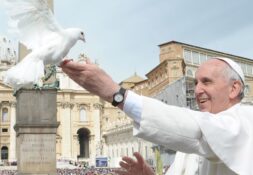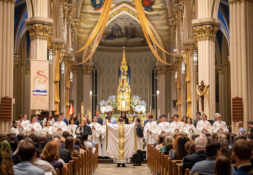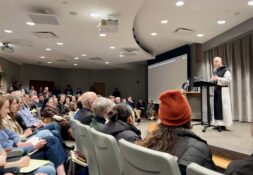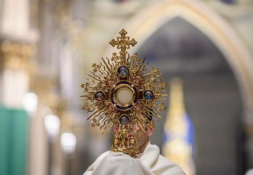Theology Club’s Zossima Project explains the anointing of the sick
Why do we anoint the sick? Do we hope for a physical cure, spiritual healing, or is it simply preparatory for leaving this world? The Sacrament of the Anointing of the Sick is abused if approached as an on-demand miracle for the suffering. As Easter approaches, we remember Christ’s mastery of death, and through that lens we understand that He is both within and beyond physical reality. Let us turn first to Holy Scripture to see what sort of healing our Lord wants to offer to us in this Sacrament.
In the First Book of Kings, the heroic Elijah becomes a model for the anointed sick. After the sign on Mount Carmel, queen Jezebel swears vengeance on him, and Elijah flees into the wilderness. As he rests fitfully beneath a tree, he prays for God to take his life. “I have had enough, Lord,” he said. “Take my life; I am no better than my ancestors” (1 Kings 19:4). Immediately an angel wakes him and provides him with food and drink. When Elijah reclines again, the angel wakes him a second time and tells him to eat more: “Get up and eat, for the journey is too much for you” (1 Kings 19:7). Once he does this, he journeys forty days and nights to Horeb, the mountain of God. This is the sustenance God offers to the faithful through the anointing of the sick. Many share Elijah’s desire for death, and only in turning to God’s gifts do they recover the strength to make the journey God has laid out for them.
Few of us do better than Job in handling our afflictions. Rather than assuming his suffering is a consequence for his sins (as his friends do), Job defends his integrity and praises God. In a beautiful discourse, he explains that fear of the Lord is the wisdom of man and his cure: “When He made a decree for the rain and a path for the thunderstorm, then He looked at wisdom and appraised it; He confirmed it and tested it” (Job 28:26-27). Still, Job remains closed to God’s healing. Elihu scolds him for thinking that his own deeds will win him protection: “He may speak in their ears and terrify them with warnings, to turn them from wrongdoing and keep them from pride, to preserve them from the pit, their lives from perishing by the sword” (33:16-18). So complete an abasement and humility is required for the sick to receive the relief they desire.
The recommendation for a formal prayer to anoint the sick is spelled out in the book of James: “Is anyone among you sick? Let them call the elders of the church to pray over them and anoint them with oil in the name of the Lord. And the prayer offered in faith will make the sick person well; the Lord will raise them up. If they have sinned, they will be forgiven” (5:14-15). Throughout both the New and Old Testaments, anointments elevate their object—kings, tabernacles, servants of the Lord. The anointing of the sick does the same, marking for the Lord those who are His own.
Just as Scripture affirms the anointing of the sick, Tradition for this Sacrament is clear during the Patristic Era. Although the early Church practiced the rite of extreme unction, the Fathers did not formulate a more defined doctrine until Nestorian and Monophysite heresies required clarification.
Third century heretics included women who performed curationes repromittere, or “undertaking of cures.” This phrasing is a direct reference to anointing the sick. Tertullian reserves the rite for priests, refuting women’s ability to perform this rite. Origen also speaks of a “salutary medicine” during penance services; these services often included anointing the sick. Origen even quotes the book of James when describing the rite: “If then there is anyone sick, let him call the presbyters of the Church, and let them impose hands upon him, anointing him with oil in the name of the Lord; and the prayer of faith will save the sick man, and if he be in sins, they shall be forgiven him.”
In the West, the Sacraments were present at early ecumenical councils. In 318, the First Council of Nicea wrote “If any man be at the point of death, he must not be deprived of the last and most indispensable Viaticum”. Viaticum here refers to the Last Rites given to the sick and dying, often the Eucharist given alongside penance and anointing of the sick.
Church Fathers in the East also affirmed the Western conciliar understanding of anointing of the sick. For example, John Chrysostom describes the Judaic priest under the old covenant unable to cleanse leprosy, announcing that the leper has been cleansed spiritually. Chrysostom describes the power of priests within the new covenant to wash away the spiritual dirt of man. Through Christ, the priest “anoint[s] him with oil in the name of the Lord”. Chrysostom declares the priest to anoint the sick not for the sake of their bodily healing, but for eternal salvation. “Let him call in the priests of the church, and let them pray over him, anointing him with oil in the name of the Lord. And the prayer of faith shall save the sick man, and the Lord shall raise him up, and if he has committed sins, he shall be forgiven.”
It was only during the Carolingian period that the Western church moved “to an increasing, nearly exclusive emphasis on the spiritual effects of anointing” (Divine Worship and Human Healing, 142). The subjects of anointing were limited to “only those whose sickness was unto death and, thus, the spiritual benefits as the forgiveness of sins and purification of the soul for the final passage from this life” (142). It was during this period that the anointing of the sick became synonymous with ‘last rites,’ and was performed in conjunction with penance and the reception of Holy Communion, which were together referred to as ‘last sacraments.’ Furthermore, priests became the exclusive ministers of the sacrament. These changes were also a response to the laity’s unwillingness to perform the strict penances of the early Church, which led many individuals to wait until their deathbeds to perform penance.
Medieval theology solidified this close cause-effect relationship between the sacrament and the remission of sins, and the theologian Peter Lombard was the first to advocate for the use of the term ‘extreme unction,’ an alternative phrase for ‘anointing of the sick’ or ‘last rites’ that emphasizes how it is a sacrament for those in extremis. For Albert the Great and Thomas Aquinas, “the remitting of sin was seen as the condition for the healing of the body” (144). They believed that extreme unction removes the remnants of sin preventing the dead from experiencing the fullness of God’s glory, and therefore, serves a similar purpose as Purgatory, rather than simply removing the guilt for sin, as in the sacrament of Confession. The Franciscans Alexander of Hales and Bonaventure also believed that anointing should be reserved for those close to death, and that “the preparation for death entailed the removal of any venial sins diseasing the soul” (144). Common practice and theology interacted, as theological treatises explained and shaped practice, and practice and theology crystallized in doctrine.
The Council of Florence (1439) “defined the primary effect of anointing as healing the soul, with the possibility also of healing the body, but not explicitly mentioning the remission of sins” (144). It was during this period that extreme unction became the last sacrament an individual received before death, as previously extreme unction was placed between penance and Viaticum. An abuse that arose out of this period was the extreme practicality of anointing: instead of being merely preparation for death, it became a declaration of death. This practice was excoriated by Protestant reformers, and the Council of Trent sought to correct this abuse. The Council allowed all those suffering from an illness to receive extreme unction, not merely those who were dying. It also did not limit extreme unction to a particular spiritual purpose; rather, it emphasized “the graceful work of the Holy Spirit removing sin and its remains, raising up the soul by instilling confidence in divine mercy (thereby strengthening against such diabolical temptations as despair), and possibly even curing the body” (145).
Late Church teaching clarified and reiterated the theology put forth by the Council of Trent. According to the Pastoral Care of the Sick, Rites of Anointing and Viaticum “give the grace of the Holy Spirit to those who are sick: by this grace the whole person is helped and saved, sustained by trust in God, and strengthened against the temptations of the Evil One and against anxiety over death. Thus the sick person is able not only to bear suffering bravely, but also to fight against it. A return to physical health may follow the reception of this sacrament if it will be beneficial to the sick person’s salvation. If necessary, the sacrament also provides the sick person with the forgiveness of sins and the completion of Christian penance” (3). Like the Council of Trent, the Second Vatican Council did not limit the spiritual purpose of extreme unction to the remission of sins or the vestiges of sin. Similarly, the recipients of the sacrament are not only the dying; anyone suffering from serious illness or even the weakness of old age can receive the sacrament, and it can be received multiple times in one’s lifetime. Only the dead are prohibited from receiving the sacrament. Furthermore, the ‘last sacraments’ are now separated and are no longer under ordinary circumstances one continuous rite.
Saints Peter and John, speaking to the Sanhedrin, model the trust in Christ’s mercy expected of the Faithful today—the trust that Elijah and Job learned and that Christians throughout the centuries have defended. Though Peter and John have already told the Sanhedrin by what power Christ heals, they still doubt. Our fathers in the Faith respond as we do too, to those who ask but do not hear, who seek healing but do not see that before they speak God provides: “Which is right in God’s eyes: to listen to you, or to him? You be the judges! As for us, we cannot help speaking about what we have seen and heard” (Acts: 4:18).
This article was brought to you by the Theology Club’s Zossima Project: Making prayer an education. For a complete works cited, please email zossimaprojectnd@gmail.com. Thank you for your readership.






Leave a Reply